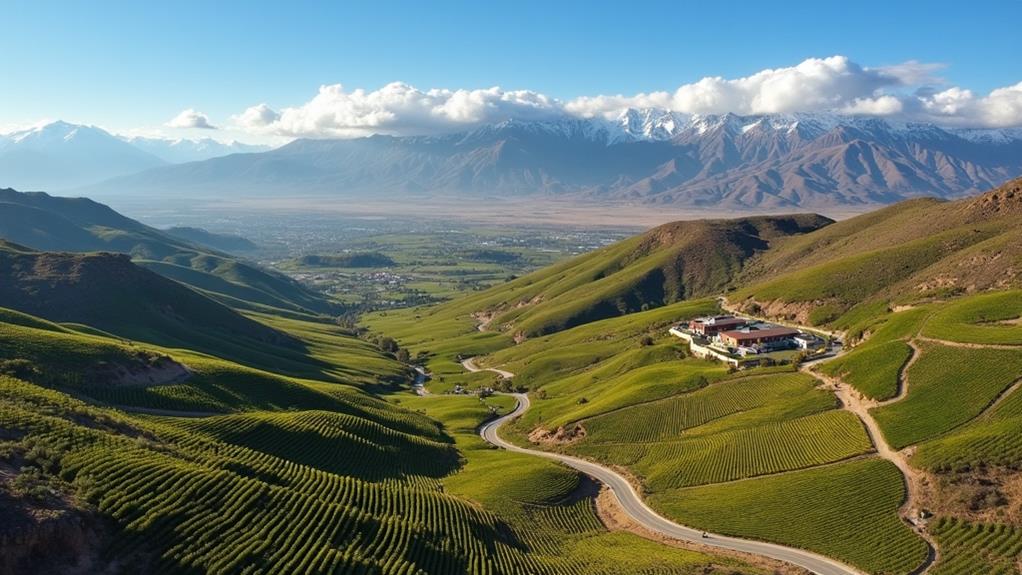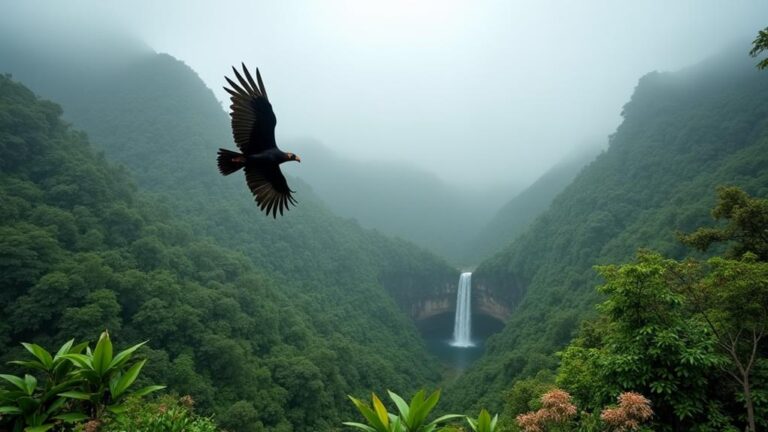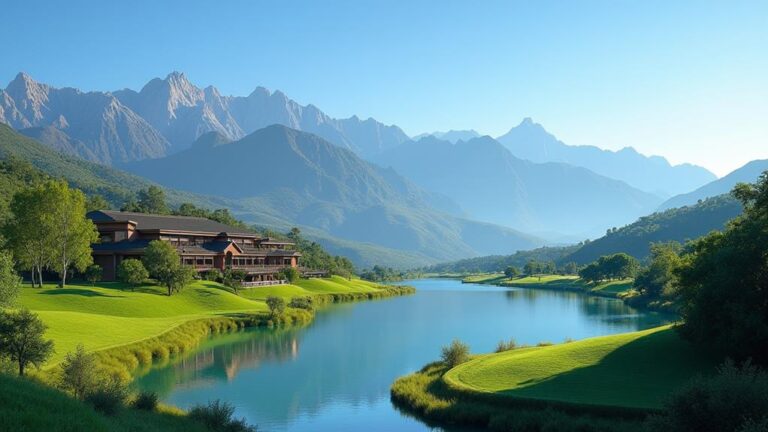If you're a wine enthusiast, Chile is definitely on your radar. With its diverse regions and unique terroir, it's a goldmine for wine connoisseurs. You're probably familiar with Chile's reputation for producing exceptional Cabernet Sauvignon and Merlot, but there's more to the story. Each region has its own distinct character, from the Mediterranean climate of Colchagua to the old-vine Carignan of Maule Valley. But which region should you prioritize? Do you opt for the established players or take a chance on the up-and-coming stars? The answer might surprise you, and it's just around the corner.
Contents
Key Takeaways
- Maipo Valley is a renowned wine region in Chile, known for its Cabernet Sauvignon and Merlot production.
- Colchagua Valley is a premier wine region, featuring a diverse array of grape varieties and notable wine estates.
- Casablanca Valley is gaining recognition for its cool-climate wines, particularly Sauvignon Blanc, Chardonnay, and Pinot Noir.
- Maule Valley's unique terroir produces wines with a blend of old-vine Carignan and Pais, alongside modern plantings of Carmenère.
- San Antonio Valley is a rapidly evolving region, characterized by its unique landscapes and coastal influences, ideal for producing crisp white wines.
Maipo Valley Wine Region
Located in the heart of Chile's wine country, the Maipo Valley wine region is a must-visit destination for any serious wine enthusiast.
You'll find the Maipo Valley nestled in the foothills of the Andes Mountains, where the unique terroir and climate make it an ideal place for growing Cabernet Sauvignon, Merlot, and other red varieties.
As you explore the Maipo Valley, you'll discover its rich history, dating back to the 19th century when it was first established as a wine region.
The Maipo history is marked by the influence of European immigrants who brought their winemaking techniques and traditions to the region.
You'll also learn about the wine pioneers who played a significant role in shaping the Maipo Valley into the renowned wine region it's today.
Some of these wine pioneers, such as the Concha y Toro and Cousiño-Macul wineries, are still producing some of Chile's best wines.
When you visit the Maipo Valley, you'll have the opportunity to tour these wineries, taste their exceptional wines, and experience the region's warm hospitality.
Colchagua Valley
As you explore the Colchagua Valley, you'll encounter some of Chile's most notable wine estates, including Montes, MontGras, and Bisquertt.
The region's Mediterranean climate, combined with varied soils ranging from clay to granite, creates a unique environment for grape cultivation.
You'll find a diverse array of grape varieties thriving in this setting, including Cabernet Sauvignon, Syrah, and Carménère, which have become hallmarks of the Colchagua Valley's distinctive wine style.
Notable Wine Estates
Colchagua Valley's reputation as one of Chile's premier wine regions is largely due to its renowned wine estates, which have garnered international acclaim for their exceptional quality and innovative winemaking techniques.
As you explore the valley, you'll discover a diverse range of wineries, from large, established estates to boutique wineries that offer unique and intimate experiences.
These boutique wineries have become a driving force behind Colchagua Valley's wine tourism, attracting visitors who seek to explore the region's hidden gems and discover new flavors.
Some notable wine estates in the region include Montes, a pioneer in sustainable winemaking, and Casa Lapostolle, which boasts a stunning winery designed by renowned architects.
These wineries, along with others, have helped establish Colchagua Valley as a world-class wine destination.
When visiting the region, be sure to schedule a tour at one of these esteemed wine estates to experience firsthand the art of winemaking and the passion that drives these innovative producers.
Climate and Soil
The Mediterranean climate of Colchagua Valley provides ideal conditions for grape cultivation, with warm, dry summers and mild, wet winters.
As you explore the region, you'll notice the coastal influence on the climate, with the Pacific Ocean moderating temperatures and preventing extreme heat or cold.
This results in a diurnal range of around 10-12°C, allowing grapes to ripen slowly and evenly.
The valley's unique geography also plays a role in shaping the climate.
The Andes Mountains to the east block cold air from the continent, while the coastal range to the west shields the valley from the Pacific's cooling influence.
This creates a microclimate that's perfect for growing a wide range of grape varieties.
The soil in Colchagua Valley is also well-suited to grape cultivation.
You'll find a mix of clay, sand, and loam soils, with some areas featuring granite or limestone deposits.
These diverse soils contribute to the region's rich flavor profiles and add complexity to the wines.
Grape Varieties
Grape cultivation in Colchagua Valley benefits from its unique combination of climate and soil, setting the stage for the growth of a diverse range of grape varieties.
As you explore the region, you'll find a mix of red and white grapes, each showcasing the valley's capabilities.
When it comes to reds, Chilean Syrah stands out for its peppery and dark fruit flavors.
You'll often find it blended with other varieties, such as Malbec and Cabernet Sauvignon, to create complex and full-bodied wines.
Carmenere Blends are another highlight of the Colchagua Valley.
This varietal, once widely cultivated in Bordeaux, has found a new home in Chile.
Its dark fruit flavors, smooth tannins, and hint of spice make it a great addition to blends.
Many winemakers in the region combine Carmenere with Cabernet Sauvignon and Merlot to create rich and approachable wines.
The resulting blends offer a perfect balance of acidity, tannins, and flavors, showcasing the valley's ability to produce high-quality wines.
Whether you prefer bold Syrahs or smooth Carmenere Blends, the Colchagua Valley has something to offer every wine enthusiast.
Maule Valley Wines
Maule Valley's rich terroir is yours to discover in its wines, which offer a unique blend of old-vine Carignan and Pais, alongside more modern plantings of Cabernet Sauvignon, Merlot, and Syrah.
As you explore the region's wines, you'll notice the distinct Maule heritage, with many producers proudly showcasing their history and traditions.
The valley's conditions are particularly well-suited for Carmenere production, a varietal that thrives in Maule's warm, dry climate.
Carmenere-based wines from Maule Valley are known for their dark fruit flavors, spicy undertones, and smooth tannins.
You'll also find wines with a blend of Carmenere and other Bordeaux varietals, adding complexity and depth to the region's wines.
Maule Valley's old-vine plantings are another notable feature, with many vineyards dating back to the 19th century.
These vines produce wines with intense flavor and character, a legacy to the region's rich wine history.
With its unique blend of old and new, Maule Valley wines offer a fascinating glimpse into Chile's wine heritage.
San Antonio Valley
Beyond the coastal mountains, you'll find San Antonio Valley, a relatively new but rapidly evolving wine region in Chile.
This valley is characterized by its unique landscapes, with rolling hills and coastal influences that have shaped the region's viticulture.
As you explore San Antonio Valley, you'll notice the valley's climate is cooler and more maritime-influenced than other regions in Chile, making it an ideal location for producing crisp and revitalizing white wines.
San Antonio Valley's proximity to the Pacific Ocean has a direct impact on its wine production.
The coastal influences bring a gentle blanket of fog to the region, which slows down the ripening process of the grapes, resulting in wines with higher acidity and mineral notes.
You'll find a variety of grape varieties thriving in this region, including Sauvignon Blanc, Pinot Noir, and Syrah.
The region's winemakers are experimenting with new techniques and grape varieties, making San Antonio Valley an exciting place to watch in the world of Chilean wine.
With its unique valley landscapes and coastal influences, San Antonio Valley is a must-visit destination for any wine enthusiast.
Casablanca Valley
Located where the coastal mountains meet the sea, Casablanca Valley is a wine region that's gaining international recognition for its cool-climate wines.
You'll notice a distinct difference in the wines produced here, thanks to the coastal influence that brings cool, foggy mornings and mild temperatures.
This unique climate makes Casablanca Valley an ideal place for growing grapes like Sauvignon Blanc, Chardonnay, and Pinot Noir.
As you explore the region, you'll discover that Chilean whites are a major focus in Casablanca Valley.
Winemakers are perfecting the art of crafting crisp and revitalizing whites that showcase the region's cool-climate characteristics.
The Sauvignon Blancs, in particular, are known for their citrus and green apple flavors, while the Chardonnays offer a rich, buttery taste.
The region's coastal influence also contributes to the wines' acidity and minerality, making them perfect for pairing with seafood and other light dishes.
With its stunning scenery and exceptional wines, Casablanca Valley is a must-visit destination for any wine enthusiast.
As you taste your way through the region, you'll understand why its cool-climate wines are gaining popularity around the world.
Elqui Valley
Elqui Valley, a narrow, arid region in northern Chile, beckons you with its unique terroir and commitment to sustainable winemaking.
As you explore this region, you'll discover the distinct Elqui history that has shaped its winemaking practices.
The valley's unique terroir is influenced by the Andes Mountains, which provide a dramatic backdrop to the region's vineyards.
The Andean influence is evident in the region's intense sunlight, low humidity, and cool nights, all of which contribute to the valley's signature wine styles.
You'll notice that Elqui Valley's wine producers are dedicated to sustainable winemaking practices, which prioritize environmental stewardship and social responsibility.
The region's focus on sustainability is reflected in its use of solar power, organic farming methods, and fair labor practices.
As you taste the wines of Elqui Valley, you'll experience the region's commitment to quality and sustainability.
From crisp whites to full-bodied reds, Elqui Valley's wines are characterized by their unique blend of flavors and aromas, which are shaped by the region's distinctive terroir and winemaking traditions.
With its rich history, stunning landscapes, and dedication to sustainability, Elqui Valley is a must-visit destination for wine enthusiasts.
Cachapoal Valley Region
In the heart of Chile's wine country lies the Cachapoal Valley Region, a place where tradition meets innovation and the scenic beauty of the Andes Mountains converges with the gentle flow of the Cachapoal River.
As you explore this region, you'll discover a rich Cachapoal history that dates back to the 18th century when Spanish colonizers first planted vines.
The region's wine production gained momentum in the 19th century with the arrival of European immigrants, who brought with them new techniques and expertise.
Today, the Cachapoal Valley Region is known for its diverse range of wines, from crisp Chardonnays to full-bodied Cabernet Sauvignons.
The region's unique terroir, influenced by the Andes Mountains, lends a distinct flavor profile to its wines.
The Andean influences are evident in the wines' minerality and acidity, which make them perfect for pairing with a variety of dishes.
As you taste your way through the region's wines, you'll appreciate the perfect balance of tradition and innovation that defines the Cachapoal Valley Region's winemaking style.
With its stunning scenery and exceptional wines, this region is a must-visit destination for any wine enthusiast.
Frequently Asked Questions
What Is Chile's Wine Production Climate Like?
You'll find Chile's wine production climate characterized by cool climates, with latitude ranges spanning 30° to 38° south, allowing for varied temperature and precipitation conditions that substantially impact the country's diverse wine styles.
Is Chilean Wine Suitable for Vegetarians?
You're the grape connoisseur, but do you know if Chilean wine is vegetarian-friendly? Many Chilean wines use animal-derived products for fining, but some winemakers opt for vegan certification, making it a suitable option for vegetarians who dig deeper.
Can You Visit Chile's Wine Regions on Your Own?
You can explore Chile's wine regions solo, traversing wine roads and cellars. Consider visiting off-season for a more personalized experience or book private tours to dig deeper into the wine-making process.
What Wine Tours Are Available in Chile?
You'll find various guided wine tours in Chile, offering wine tastings and vineyard strolls. Options range from full-day excursions to multi-day wine country getaways, allowing you to immerse yourself in Chile's thriving wine scene.
How Do You Pair Chilean Wine With Food?
You're done sipping mediocre wine with pizza – it's time to level up. Pair Chilean wine with food by matching rich Cabernet's bold flavor profiles with grilled meats, and crisp Sauvignon Blanc's citrus notes with seafood.
Conclusion
As you've explored Chile's wine regions, the memories of rich flavors and breathtaking landscapes will linger. Each valley, a unique canvas of terroir and tradition, has told its story through the wines that call it home. From the bold notes of Maipo to the crisp whites of San Antonio, the journey has been a sensory tapestry, weaving together the essence of Chile's wine culture, leaving you with a lasting impression and a thirst for more.









